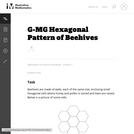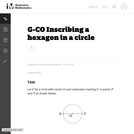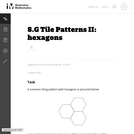
This Unit is Transdisciplinary reinforcing the importance of the honeybee.
- Subject:
- Applied Science
- Environmental Science
- Life Science
- Mathematics
- Material Type:
- Activity/Lab
- Date Added:
- 03/06/2019

This Unit is Transdisciplinary reinforcing the importance of the honeybee.

This task applies reflections to a regular hexagon to construct a pattern of six hexagons enclosing a seventh: the focus of the task is on using the properties of reflections to deduce this seven hexagon pattern.

The goal of this task is to use geometry study the structure of beehives. Beehives have a tremendous simplicity as they are constructed entirely of small, equally sized walls. In order to as useful as possible for the hive, the goal should be to create the largest possible volume using the least amount of materials. In other words, the ratio of the volume of each cell to its surface area needs to be maximized. This then reduces to maximizing the ratio of the surface area of the cell shape to its perimeter.

This task is primarily for instructive purposes but can be used for assessment as well. Parts (a) and (b) are good applications of geometric constructions using a compass and could be used for assessment purposes but the process is a bit long since there are six triangles which need to be constructed.

ile patterns will be familiar with students both from working with geometry tiles and from the many tiles they encounter in the world. Here one of the most important examples of a tiling, with regular hexagons, is studied in detail. This provides students an opportunity to use what they know about the sum of the angles in a triangle and also the sum of angles which make a line.

Beavers are generally known as the engineers of the animal world. In fact the beaver is MIT's mascot! But honeybees might be better engineers than beavers! And in this lesson involving geometry in interesting ways, you'll see why! Honeybees, over time, have optimized the design of their beehives. Mathematicians can do no better. In this lesson, students will learn how to find the areas of shapes (triangles, squares, hexagons) in terms of the radius of a circle drawn inside of these shapes. They will also learn to compare those shapes to see which one is the most efficient for beehives. This lesson also discusses the three-dimensional shape of the honeycomb and shows how bees have optimized that in multiple dimensions. During classroom breaks, students will do active learning around the mathematics involved in this engineering expertise of honeybees. Students should be conversant in geometry, and a little calculus and differential equations would help, but not mandatory.